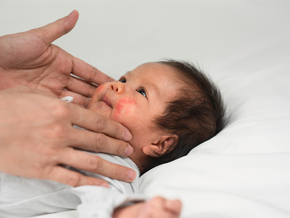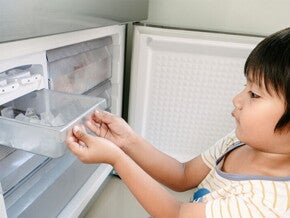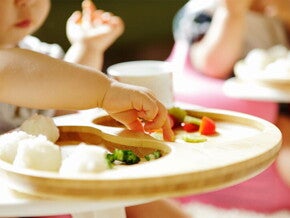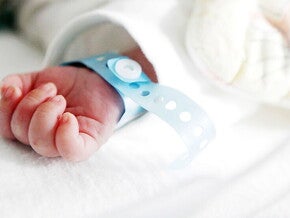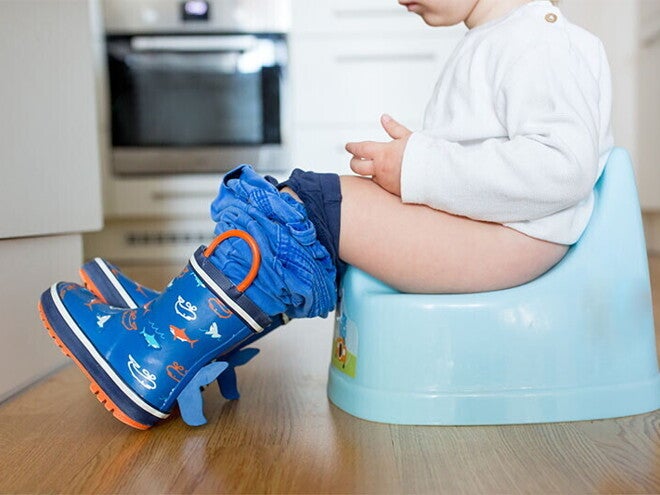
A Guide to your Child’s Poop
By: Katrina Anne Valera, MD, DPPS, DPSPGHAN
Many new parents wonder what's HEALTHY and what's not when it comes to their child’s poop.
Your child’s poop can say a lot about their health. How often they go to the bathroom, how easy or difficult it is for them to poop and how much poop they expel can indicate your child’s general digestive health or dietary needs, that is why it is important to pay attention to their poop. To really understand what their poop is telling us, we need first to understand how it is made, what it is made of, and what characteristics to pay attention to.
HOW IS POOP MADE?
Poop is one of the end results of the digestive process. After you eat, food makes its way through the esophagus going to the stomach, where it is broken down further for the nutrients to be readily absorbed by the body. Any leftover material is transported to the large intestine where trillions of bacteria continue to break down the food that your body couldn’t. Anything that’s left exits your body as poop.
WHAT’S IN POOP?
Poop is made up of mostly water (75%) and the remaining (25%) is a combination of solid materials: cellulose (30%), bacteria (30%), Inorganic substances (10-20%), Cholesterol and fats (10-20%), Protein (2-3%), cells and mucous.1 It is estimated that within each gram of poop there are nearly 100 billion bacteria.2 Chemicals and bacteria give poop its distinct odor.
DOES POOP CHANGE WITH DIET CHANGES?
You are what you eat so is your poop. Once solid foods are introduced at six months of age, whether they are breastfed or formula-fed, a baby’s poop becomes more solid and formed. Because of the added sugars and fats, they will have a much stronger odor too. You may find bits of vegetables in the diaper, as these are hard to digest. After the introduction of solid foods, your baby may experience constipation or diarrhea which can be clues that they are not tolerating a new food.6 If you change from breast milk to milk formula, you'll find your baby's poops become darker and firmer while babies who are mixed fed (breastmilk and milk formula) have poop that are softer compared to those who are purely formula fed.4
Giving your child a new milk can cause temporary changes in the color, consistency and frequency of their poop becoming more solid, firmer, and dark green in color while some may find formulas harder to digest, leading to gas, cramps, and watery poop. No need to worry! These are normal responses when switching formulas, since your baby's stomach is sensitive to changes. Give your baby time, usually up to 2 weeks8 to adjust to the new formula. The soft or watery stool improves on its own within 24 hours, but if it worsens or persists, make sure to consult your child’s pediatrician.
CHARACTERISTICS OF “HEALTHY” POOP
In the first few days after birth, baby's first poop is a sticky, black or dark green substance, called meconium. A few days after, breastfed baby’s poop is seedy, soft, yellow or mustard like. The odor should be mild and not unpleasant. Occasionally seeing mucus in the poop is normal.6 Those who are formula-fed have slightly more solid poops that are darker yellow with hints of green and are more smelly. In older children, their poop should be soft but formed and is brown in color due to the solid food that they eat.
DOES MY BABY HAVE CONSTIPATION?
The frequency of bowel movements varies widely depending on the age group. During the first 24 hours, your baby should poop at least once and in the second 24 hours, at least twice. At three to five days old, they should make at least three poops each day.
Exclusively breastfed newborn babies up to 2 months of age may poo after each feed while some poop only once a week and this is still normal.5 It is likely because their bodies are absorbing all the nutrient-filled breast milk they are drinking. It's also normal for babies to strain or even cry when pooping. Your baby isn't constipated as long as their poops are soft. Infrequent poop should not be considered a problem as long as there is no vomiting, abdominal distention, baby is gaining weight steadily and nursing regularly.
Formula fed babies poop 1 to 8 times a day during the first week, then it starts to slow down to 1 to 4 per day, until 2 months of age. For toddlers and older children, frequency decreases as they get older, pooping one to two times a day at least three times a week is normal.
Dry, hard, bulky stools that are difficult to eliminate are signs of constipation. It’s important to remember that constipation isn’t just about how frequently your child is pooping, but also about how hard it is for them to do so.
Older children who are constipated poop fewer than three times a week.7 It is caused by a diet lacking in fiber, water and physical activity, certain medications, or due to bowel disorders.
DOES MY BABY HAVE DIARRHEA?
On the other hand, if your child has poop that is loose or watery, occurring three or more times a day or more often than what is normal for him, then your child is nagtatae. In majority of cases, it lasts only for a few days and stops on its own as these are usually due to viral infections. However, if the pagtatae persists or worsens, accompanied by fever, vomiting, poor appetite, decreased urination, presence of mucus or blood in the poop or is noted to be foul smelling, the pagtatae could be due to a bacterial infection, it is best to bring your child to the hospital right away.
Eliciting an adequate description of a child’s stool pattern can, however, be difficult and unreliable. Brussels Infant and Toddler Stool Scale (BITSS) is a visual stool scales that is used as an aid in the assessment of stool consistency of infants and toddlers who are non- toilet trained or are still wearing diapers.3 Stools are grouped into Hard, Formed, Loose and Watery stools based on the pictures shown below.
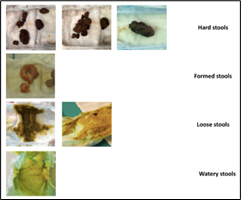
WHEN SHOULD YOU WORRY ABOUT YOUR BABY’S POOP?
Poop should not be black, white or red. A black poop may be caused by taking iron supplements or it could be a sign of gastrointestinal bleeding, white/ acholic poop may indicate a liver problem. Red poop tells you that something is not right, usually a bleed. Any persistent bleeding should prompt you to bring your child to the doctor right away.
References
- Mawer, S. Physiology, Defecation NIH Nov 13, 2023
- Sender, R. Revised Estimates for the Number of Human and Bacteria Cells in the Body. PLoS biology 2016
- Huysentruyt, K. The Brussels Infant and Toddler Stool Scale: A study on inter-observer Reliability. J Pediatr Gastroenterol Nutr. 2019 Feb
- Baalema, D. What are Normal Defecation Patterns in Healthy Children up to Four Years of Age? A Systematic Review and Meta-Analysis. The journal of Pediatrics. October 2023
- American Academy of Pediatrics. Caring for Your Baby and Young Child: Birth to Age Five 8th edition. 2024
- La Leche League International. Poop and Pee in the exclusively breastfed Baby. Published January 2018, revised September, 2024
- Rome IV Diagnostic Criteria For Functional Constipation
- A guide on how to transition to a new formula. SMA® Nutrition UK and Ireland. ®Reg. Trademark of Société des Produits Nestlé S.A. ZTC5480/06/21













